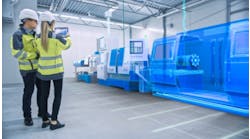By Charlie Neagoy, SVP of Customer Success at Librestream
Before the worldwide pandemic, many businesses and industries were already facing problems on the workforce front. COVID-19 only accelerated the unique challenges field workers were up against. From travel restrictions to maintaining social distancing to continued hybrid/remote work, this period also brought many opportunities that will continue to flourish way beyond the pandemic. In fact, organizations have been reimagining the way they work and introducing collaboration tools that connect their on-site workers with back-office staff.
Today, leading organizations have begun to recognize the untapped potential that technologies like augmented reality (AR) and virtual reality (VR) have to offer when it comes to connecting their remote workers in the field around the world.
Not only are these technologies able to help maintain business continuity in these continued challenging times and beyond, they also enable firms to perform seamless remote inspections, monitor services more thoroughly and can align customers, co-workers, and remote experts seamlessly through virtual connections.
The impact and challenges on the manufacturing workforce
The manufacturing industry is faced with a unique challenge where almost 25% of the sector’s workforce is age 55 or older. With many workers retiring in the next five to ten years, the need for AR technology to help train a new era of manufacturing workers has become urgent. AR in manufacturing can be deployed across a wide range of manufacturing operations, provide immediate remote access to subject matter experts (SMEs), and step-by-step digital work instructions to enable effective training and onboarding.
Reaping the benefits of AR/VR technologies
For manufacturers to combat the challenges of limited skilled labor, AR and VR technologies can provide unprecedented value, for the business bottom-line and for the ultimate user: field workers. Key benefits organizations can gain are below.
Enhanced training, onboarding, and reskilling: The use of AR and VR technology to aid manufacturing operations has many benefits including enhanced training, onboarding, and reskilling. Amid labor shortages, the great resignation, and subject-matter experts retiring, training for new employees entering the deskless workforce is one of the most important steps to future-proof and, at the same time, one of the biggest challenges due to lack of knowledge transfer.
Immersive technology enables people fresh to the industry—or those less tenured—the ability to gain practical and realistic expectations of what the work environment is like, which in turn reduces the chances of someone getting injured in the field. This also helps them learn processes faster and do their work more efficiently with the right resources. New manufacturers can be provided with step-by-step digital work instructions, resulting in faster onboarding, productivity gains, and decreased training costs for businesses.
Along with new employees, people that have been in the industry for years can benefit from AR and VR technology to upskill and reskill. Reskilling the current workforce by leveraging digital technology enables the industry to stay ahead of automation trends and prevent knowledge gaps within the industry.
Instant accessibility to expertise: With heavy machinery becoming much more complex and new technology being adopted in every industry, organizations require specialized knowledge and skillsets to maintain, repair, and support for daily operations. When workers are in the field, many questions and concerns arise, leaving them puzzled and causing productivity to decrease.
The skills and knowledge needed to properly learn how to operate equipment often takes considerable time to develop. Industrial-enabled AR can help workers access the right expertise, tools and knowledge at the right time, providing them access to a subject matter expert (SMEs) in minutes. Experts can easily assist field workers with diagnosing, inspecting, and troubleshooting assets, all while being remote.
Ultimately, AR helps connect workers with resources located outside the field, helps manufacturers improve asset uptime, accelerate time to market for new product introductions, and deliver superior customer service.
Lower O&M costs: Given workforce shortages, the widening skills gap, and lack of immediate access to relevant information, organizations are facing increasing knowledge loss; and the costs associated with repeatedly training new workers can be significantly high.
When leveraging AR and VR technology, enterprises can reduce their investments in maintaining business operations. Costs associated with training, equipment maintenance, and production can be cut by a significant amount when a successful AR and VR plan is implemented.
Leveraging technology to educate workers minimizes the need for travel and producing digital learning lessons provides key benefits for field workers and businesses. Additionally, equipment downtime can cause massive profit losses, but without connected worker technology in the field, quick fixes cannot always happen. Workers unfamiliar with down equipment and the unavailability of experts can cause costly disruptions.
With AR-based digital instruction, today's manufacturers can speed up equipment maintenance and repair time, resulting in less interruption of production and fewer operating costs.
Enhancing the future of the manufacturing industry
Throughout many facets of the manufacturing industry, it is illustrated that AR and VR technologies can be incorporated at every step to improve training, accessibility to experts, and profits. The ongoing COVID pandemic has led to tremendous opportunities for industry to advance knowledge in the workforce and offset the business impact of veteran workers leaving the field through technology. In the coming years, digital transformation and remote solutions for manufacturers should be considered the norm and not just an abstract tool discussed in theory.

